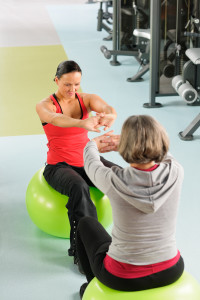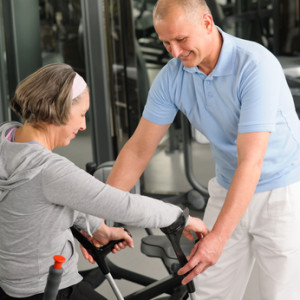It is a bit shocking when I realize I have been teaching fitness since 1975 right out of high school. I started teaching basic dance aerobics, which were the first version of high/low aerobics by Jacki Sorensen. I taught my first class with a vinyl 45 record album on a record player which was a long way from today’s Pandora, iPod or iPhone. After obtaining a master’s degree in physical education and teaching physical education in a high school for 9 years, I decided to go into fitness full-time. It did not take me long to understand the need for additional training in the fitness world, and I became a presenter for IDEA Health and Fitness Association in 1994.
From there I branched out to become a master trainer for multiple organizations and saw the industry change. In the process, I have seen fads, equipment, programs and gurus come and go. The themes I have seen over these past 40 years are as follows:
- The American population either over exercises or under exercises.
- Gurus come and go or have lasted a bit longer because they were either a one hit wonder or just changed their angle, toy, or approach.
- New equipment was a hit for a brief period due to lack of education, cookie cutter programs or injury over time.
As an independent fitness educator working for various companies, I see students from all certifications and organizations. Regardless of the organization or time in the field, these are the following themes I have observed to which I believe there is a breakdown in the education system. Even students who come to class with an Exercise Degree from a University, I find the same issues:
- Students are taught to memorize.
- Students are taught a specific program – exercise or choreography.
- Students are taught to promote intensity, weight loss, or muscle gain.
 I believe we are at a crossroads in the fitness industry. Professionals must be groomed to become Medical Fitness Experts. This does not necessarily mean rushing out and obtaining an advanced certification but instead, it means the following:
I believe we are at a crossroads in the fitness industry. Professionals must be groomed to become Medical Fitness Experts. This does not necessarily mean rushing out and obtaining an advanced certification but instead, it means the following:
1. We must go back and understand how to apply the basic sciences of:
- Anatomy – muscles, tendons, ligaments, fascia, bones etc.
- Exercise Science – the function of our organs and muscles and the energy pathways that drive them.
- Kinesiology – joint actions, the muscles used, the pull of gravity, roles of the muscles etc.
2. We must be able to observe the client’s movement patterns and see any compensations or dysfunctions. If so, we need to be able to teach new mechanics and new movement patterns.
3. We must be able to observe posture and alignment both static and dynamic. This will be the basic program design to strengthen weak muscles and stretch tight muscles.
4. We must understand the gait pattern and correct problems or refer out if we are not confident in our approach.
5. We must build a network of multi-disciplined professionals to ensure total wellness for our clients through: referrals, gathering information, discussing certain issues, getting validation on various program ideas, or clarification when needed etc.
6. We must be able to observe, gather information, analyze, hypothesize, and implement. We must later re-evaluate and modify or adapt as needed for further improvement.
7. We must include the client in this process. We need to ask, listen, and allow the client to help us get a game plan.
8. We must understand human behavior and psychology to know each client at a deeper level. We need to meet the client where they are with no judgement, but instead empathy and understanding. This will lead to a personal prescription based on physical and psychological needs.
9. We must apply the following principles to each personal prescription:
- What is the purpose?
- Is this working? (Joint action, gravity pull, etc.)
- Are there any stress points or compensations?
- Is the load appropriate and if not, how do I regress or progress?
- What is the functional and postural outcome of this exercise?
Joint pain is the number one reason for doctor visits. It is imperative to evaluate a prescribed program to make sure the risk benefit ratio is correct. Remember, what you do with the client today may affect them in 20 years. We must evaluate the program to assure it is truly functional for the client. Once again, function does not mean a particular exercise but instead the outcome we are seeking. A proper program should make a client feel invigorated and have less joint pain, not the opposite.
 Let’s take a deeper look at where we are! We have more individuals signed up at fitness clubs, we have more fitness clubs and more personal trainers than ever before, but ironically we have more obesity and metabolic syndrome than ever before, which means, what we are doing is not working! We need to educate our clients and empower them to take personal responsibility for their health. This could mean several things:
Let’s take a deeper look at where we are! We have more individuals signed up at fitness clubs, we have more fitness clubs and more personal trainers than ever before, but ironically we have more obesity and metabolic syndrome than ever before, which means, what we are doing is not working! We need to educate our clients and empower them to take personal responsibility for their health. This could mean several things:
- Give homework to the clients so they can become accountable and knowledgeable.
- Give corrective exercise which is an outcome not a particular exercise – it is designed to mitigate compensations, dysfunctions, poor posture, poor movement patterns, muscle imbalances and any other asymmetry.
- Encourage behavior modification through proper programming, mastery and self-efficacy.
Our industry is evolving very quickly where the medical and fitness worlds are aligning. This is no longer a fad or phase or another opportunity to capitalize on aesthetics or weight loss, but instead a necessity to improve a broken healthcare system. It is a chance to educate the part of the population that is over exercising or exercising incorrectly as well as connect with the deconditioned and non-exercisers that compose the largest percent of the population. The big question is are we ready?
The basic fundamentals must be mastered and implemented by all fitness professionals before they move on to the next level, which would be to get an advanced certification to train special populations in multiple areas. We need to be thoughtful in our choices for continuing education. We must not take the first and easiest route to get CEUs just to update our certifications. We must look at what we are lacking in our toolbox and what we do not understand in our toolbox. We may need to go back and pick up some of the fundamental sciences which will allow us to progress to more advanced learning with applicable information. It will be worth every penny to travel, attend a live workshop, petition CEUs, and whatever else is needed to gather the necessary knowledge. It is important to go the extra mile and to invest in your future and further understanding of your profession. Commit to becoming a true professional in your field and a lifelong learner as well as taking the time to build your network because we know we cannot be an expert in all fields of wellness. Stay connected, keep the passion and enjoy the journey!
Dianne McCaughey Ph.D. is an award winning fitness specialist with more than 35 years experience in personal training, group exercise, coaching, and post-rehabilitation. She is a master trainer for multiple companies and practices and teaches optimal wellness emphasizing the mind, body and spirit. She works with special populations and focuses on posture, gait, balance and corrective exercise programs for better function and health.

